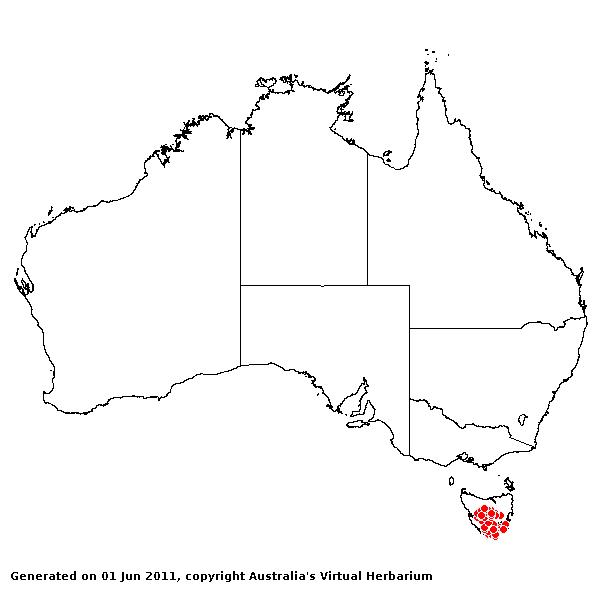Rytidosperma fortunae-hibernae (Renvoize) H.E. Connor & E. Edgar. New Zealand J.
Bot. 17: 332 (1979).
Classification. (GPWG 2001) : Subfamily
Danthonioideae. Tribe Danthonieae.
Basionym and/or
Replacement Name: Danthonia
fortunae-hibernae Renvoize, Kew Bull. 30(4): 596 (1975).
Type of Basionym or
Protologue Information: Australia: Tasmania grown at Kew from a sod
collected on Mount Read in Jan 1972 by Lord Talbot de Malahide, (HT: K).
Recent synonyms: Danthonia fortunae-hibernae.
Key references
(books and floras): [2002] D.Sharp & B.K.Simon, AusGrass, Grasses of
Australia.
Illustrations:
[2005] K.Mallet (ed.), Flora of Australia 44B: Poaceae 3 (Fig.
12, G-H).
Habit.
Perennial. Rhizomes present, elongated. Culms erect or geniculately ascending,
20–38 cm tall. Leaf-sheaths glabrous on surface. Ligule a fringe of hairs.
Leaf-blades 6–15 cm long, 1–2 mm wide. Leaf-blade surface glabrous or
indumented.
Inflorescence.
Inflorescence solid, a panicle. Panicle oblong or ovate, 2–3.5 cm long.
Spikelets.
Spikelets pedicelled. Fertile spikelets many flowered, with at least 2 fertile
florets (2–4), comprising 2–4 fertile floret(s), with diminished florets at the
apex, cuneate, laterally compressed, 7–11 mm long.
Glumes. Glumes
similar, thinner than fertile lemma. Lower glume ovate, membranous, without
keels, 3–5 -nerved. Upper glume ovate, 8–11 mm long, membranous, without keels,
3–5 -nerved.
Florets.
Fertile lemma 1.4–8 mm long, without keel. Lemma surface indumented. Lemma apex
lobed, awned, 1 -awned. Median (principal) awn from a sinus, 5.4–10 mm long
overall, with a twisted column. Lodicules present. Anthers 3. Grain 1.3–1.5 mm
long.
Continental
Distribution: Australasia.
Australian
Distribution: Tasmania.
Tasmania: West
Coast, Central Highlands, South West, Mt Field.
Notes.
R. fortunae-hibernae is closely related to R. pauciflorum and R.
dimidiatum by the relatively long rachilla internodes, the brown and purple
glumes, and the short lemma setae. It differs from R. pauciflorum by the
setae more or less as long as the lobes, and glumes more than 7 mm long; and
from R. dimidiatum by the smaller spikelets, with more spikelets in a
more compact inflorescence, and by the rachilla twice as long as the callus,
and the sparser lower row of hairs.
Tasmanian
endemic, altitude 1100–1300 m, rock crevices and stony road margins at high
altitudes; recorded from forests, cliffs and heaths in the subalpine. Flowers
Feb.



